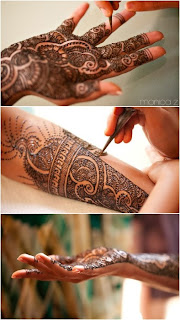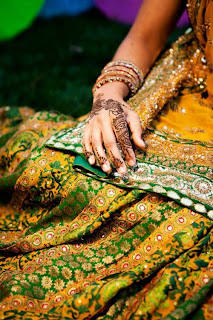Thursday, April 25, 2013
Henna Mehndi
History of Henna Mehndi
For centuries, mehndi — the art of henna painting on the body — has been practiced in India, Africa, and the Middle East, where the henna plant is believed to bring love and good fortune, and to protect against evil. Mehndi is traditionally practiced for wedding ceremonies, during important rites of passage, and in times of joyous celebration. A paste made from the crushed leaves of the henna plant is applied to the skin, and when removed several hours later, leaves beautiful markings on the skin that fade naturally over 1 to 3 weeks.
What is Mehndi? Mehndi/Henna has evolved and become more than just a tradition. It is now a fashion statement! Elegant and couture…if one of our packages do not fit your needs or style we are happy to customize one for you.
Henna Today
Until the art of mehndi became hot news in 1996, henna was mostly used in the United States as a hair dye. Widely recognized now as a wonderful way to dye the skin and to achieve the look of a tattoo, traditional henna uses and application processes have gone contemporary. Although some will always prepare their own henna paste, mehndi kits of varying quality, with foolproof instructions and convenient stencils,
Here a few design and picture of Henna Mehndi
Wednesday, April 17, 2013
Henna Tattoos
Henna Tattoos
Henna tattoo Staining the nails, skin and hair with hennas is the favorite manner of enhancing beauty amongst ladies in the Mideast. it's used as each a hair treatment further as a dye to create decorative designs on the skin. Henna cosmetics ar made of the Egyptian evergreen, Lawsonia inermis, whose shoots associated leaves yield an extract that is mixed with catechu, associate astringent substance obtained from numerous trees and shrubs. Arabians crush dried berries from this plant to get a red powder. Henna tattoo
Some picture and design of Henna Tattoos for your inspiration :
Monday, April 8, 2013
Henna Tattoo Designs

Henna Tattoo Designs

Henna Tattoo Designs

Henna Tattoo Designs
 Henna Tattoo Designs
Henna Tattoo Designs

Henna Tattoo Designs
What is Henna tattoo ?
The Henna plant traces its roots to Egypt, from wherever it was brought as a gift for the Queen Mumtaz in Asian country. The Mughals then inspired the usage of henna as a beauty product and an ornamental application on the skin, particularly at the time of weddings. The history of the henna tattoo dates back nearly 5,000 years, when the Egyptians used them on their hands, hair and nails. Even the fingers and toes of Pharaohs were stained with henna before mummification. Henna is also believed to be a logo of excellent luck and is applied before any auspicious event in various countries, like Asian country, Turkey, iraq and saudi arabia.
Benefits of henna
The henna plant is also used as an ingredient in some hair dyes and skin conditioners. Henna tattoos, which can be beautiful and highly detailed, often feature floral patterns or repeating geometric shapes, though design options are unlimited. Because henna tattoos are not permanent like ink tattoos, they make a great temporary skin design option. Henna dye is inexpensive and widely available. While henna tattoos may be applied professionally in salons, individuals who wish to create their own tattoos may purchase henna tattoo kits online or at some boutiques, bookstores or import stores.
Henna tattoo history
For thousands of years man has liked to decorate his body. Before even primitive apparel came about mans means of being part of a tribe or to be spectacularly different would be to stain the body with vegetation dyestuffs.
The results were truly incredible and henna beside other dyestuffs like indigo was a temporary yet extremely persuading way of conceiving a deep colour on the skin.
Henna (from the vegetation lawsonia inermia) is renowned as many titles and is predominantly found in North Africa, Eygpt, India and components of the Middle East. It is best renowned for its dried, ground departs that produce a colourfast dyestuff in shades varying from pale brown through to dark russet reds. It can be utilised to dye hair, skin, apparel and even digit nails, and has long been utilised as a treatment for sunburn, for its astringent features and furthermore as a sedative.
The art of Henna has been practised for thousands of years in the nations mentioned overhead but in the last 5 years there has been a surge of interest from Western nations. It is now broadly accepted as an art in self sign and individuality.
Tuesday, April 2, 2013
Subscribe to:
Posts (Atom)




.jpg)




